This post may contain affiliate links. Please read our disclosure policy.
This 5-ingredient homemade protein powder is made from wholesome seeds with no chemicals or fillers, is easy to customize, loaded with nutrients, versatile, and naturally vegan & gluten-free!
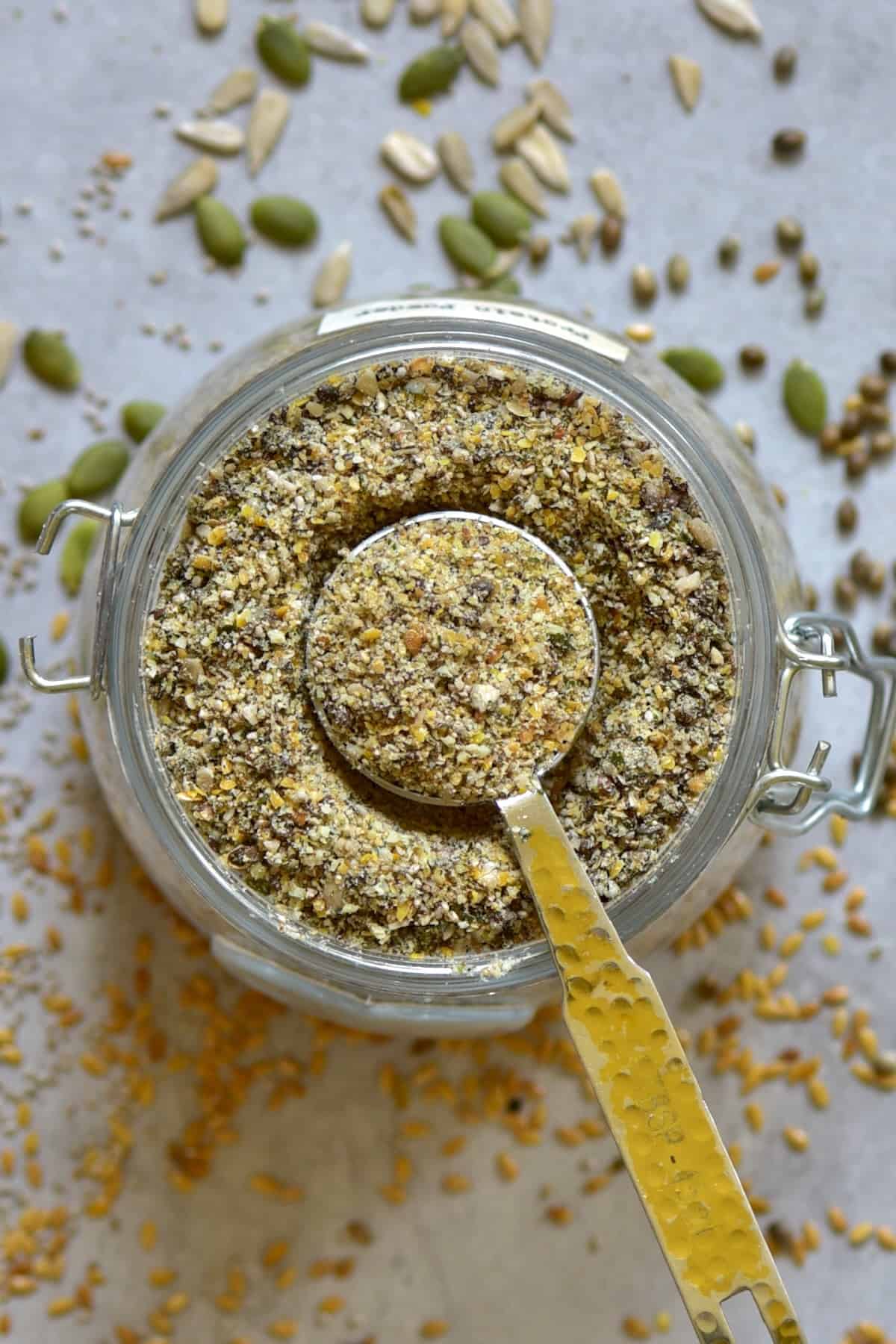
This homemade protein powder uses a blend of 5 high-protein seeds for a cheaper (especially if they’re already in your pantry), cleaner way to boost your protein with no chemicals, fillers, or gums. Just clean, high-quality ingredients, easy to customize to your dietary and flavor preferences.
Combined, this DIY vegan protein powder recipe will help keep you feeling full for longer, aid with muscle growth and tissue repair, provide a vitamin/mineral and omega boost, and several other benefits. These may include reduced inflammation and blood pressure, regulating blood sugar levels, and improved skin, brain, and heart health.
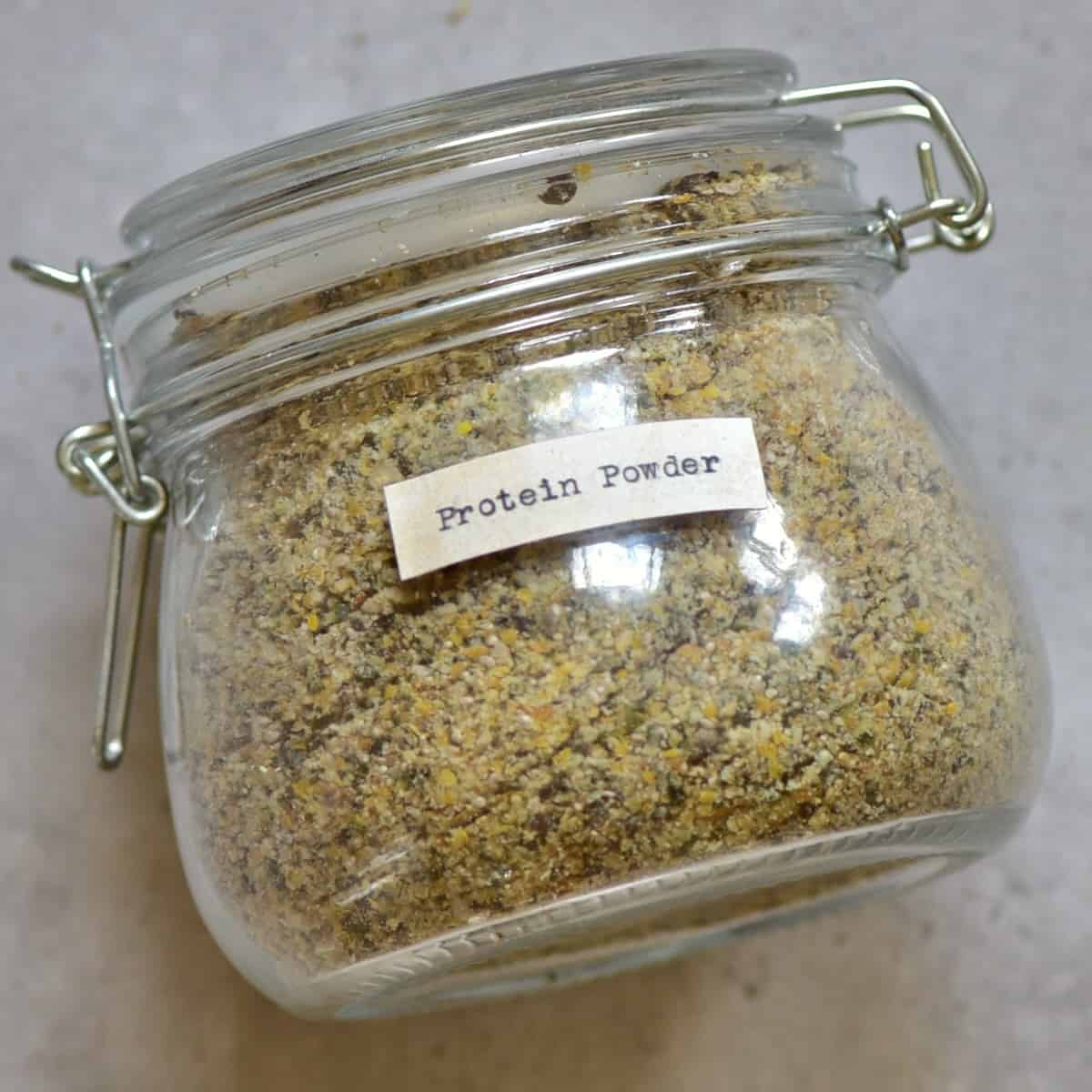
While it’s not 100% comparable to store-bought versions, this DIY protein powder is quick and simple to make and customize, will save you money, and is great to add to smoothies, post-workout shakes, baked goods, oatmeal, salads, and more!
Want to save this recipe?
Ingredients for homemade protein powder
- Hemp Seeds: Make sure to use shelled hemp seeds/ hemp hearts (the ones photographed aren’t shelled). The shells are too hard to digest. These seeds contain an optimal ratio of omega-6 to omega-3, several minerals, 30g protein per 100 grams, and are a high-quality complete source of plant-based protein.
- Chia Seeds: These tiny seeds contain 18g of protein per 100 grams, gut-healthy fiber, omega-3 fatty acids, and plenty of antioxidants.
- Flax Seeds: (aka linseed) You can use golden or brown linseed, which contain healthy omega-3s, lignans (a potent antioxidant), and about 18 g protein per 100 grams.
- Pumpkin seeds: (pepitas) These rich, green seeds contain 19g of protein per 100 grams and are a rich source of magnesium, iron, zinc, and plenty of antioxidants.
- Sunflower Seeds: Last but not least, this small but mighty seed is filled with nutrients, including a healthy dose of magnesium, potassium, zinc, iron, folate, and vitamins A, B, and E. They also contain 21-23g protein per 100g and ZERO cholesterol.
- Vanilla powder: (Optional) If you plan to serve the homemade protein powder in sweet formats only, a small amount of vanilla powder is a great way to boost flavor.
Alternatively, add 2-3 tbsp cacao powder for homemade chocolate protein powder or freeze-dried berries for a berry flavor.
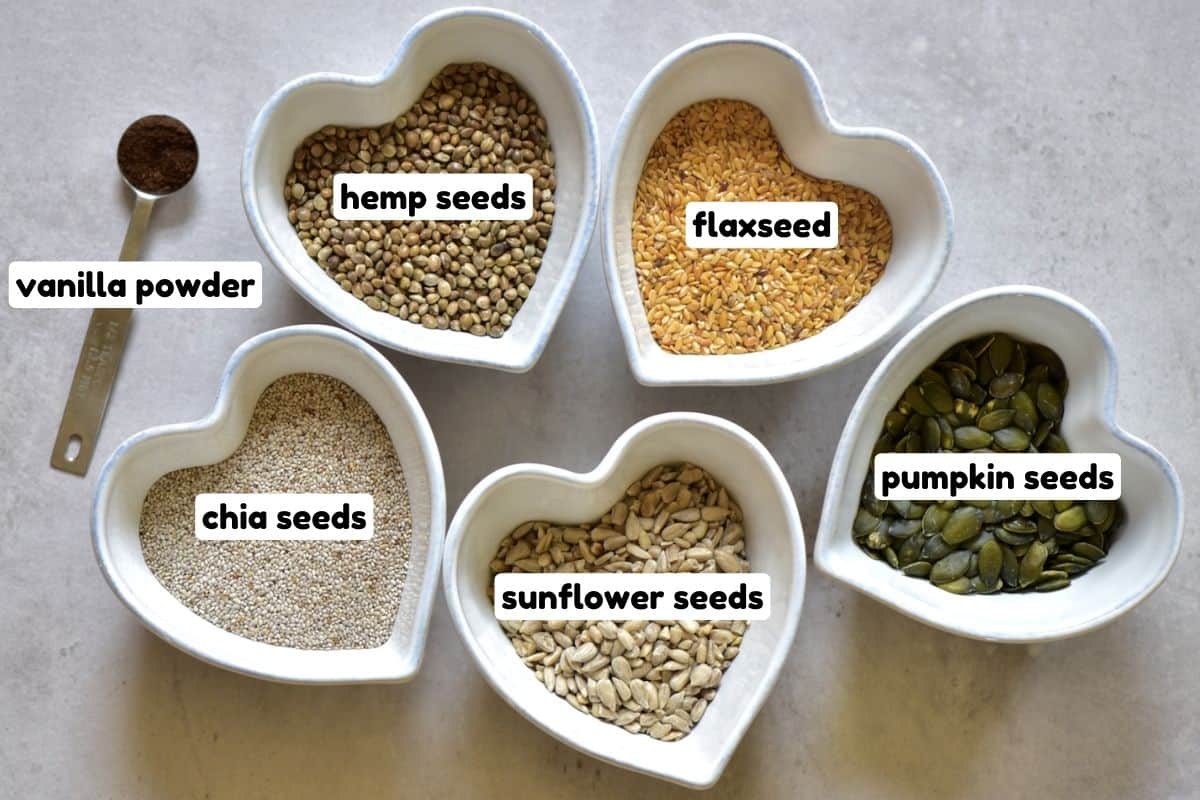
What else could I add for a protein boost?
There are several ways to customize this DIY protein powder with additional high-protein ingredients, such as:
- Peanut powder (which contains 48-49 grams of protein per 100 grams)
- Pistachios (which contain 20 g protein per 100 grams) – or cashews, walnuts, almonds
- Pea protein isolate (which contains a whopping 80-84 g protein per 100 grams)
- Whey protein isolate (dairy-based, 90 g protein per 100 grams!)
- Whey protein concentrate (usually between 70-80g protein per 100 grams)
How to make your own protein powder
Grind each seed individually in a high-speed blender or coffee/spice grinder. As a general rule:
- Hard seeds/nuts: Grind for 10-15 seconds or until you achieve a fine, powdery consistency. Pause and check the consistency to avoid over-processing them, as they can start turning into seed butter.
- Soft seeds: Grind for 5-10 seconds, and be cautious not to over-process them, or they can become gummy.
Then, transfer the protein blend to an airtight jar/container and shake/stir to combine.
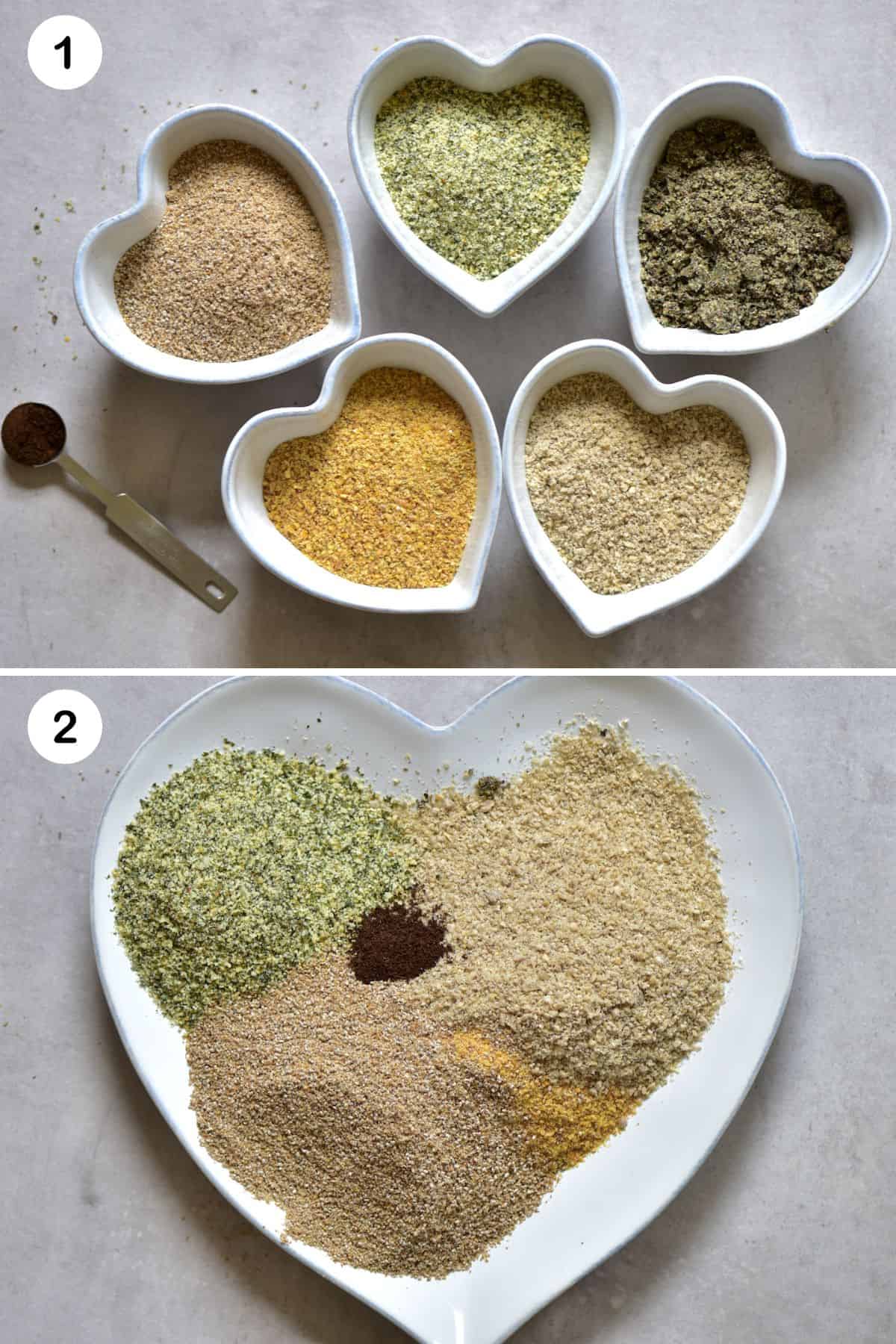
Why it’s important to grind each seed separately
- For the best consistency: Just like when making nut and seed butter, different seeds have different hardness and oil levels. That means they’ll take a different amount of time to achieve the same powdery consistency. Grinding them individually allows you to ensure that you have the most consistent and even texture throughout.
- To avoid over-processing: As certain seeds, like chia and flax seeds, become gummy if over-processed – which is likely when blending everything together.
- For maximum nutrients: The longer you grind ingredients, the hotter the machine becomes, which can lead to nutrient degradation. Individual grinding ensures this is kept to a minimum. Likewise, some seeds, like flax seeds, are best if ground just before using them to preserve nutrients (their Omega-3 fatty acids) and keep them from becoming bitter too soon.
- To customize the blend: For example, the ratio within the blend, thus overall flavor and texture. That way, you can more easily experiment with various combinations and proportions. If you aren’t keen on any of the ingredients, just leave it out or swap it for something similar.
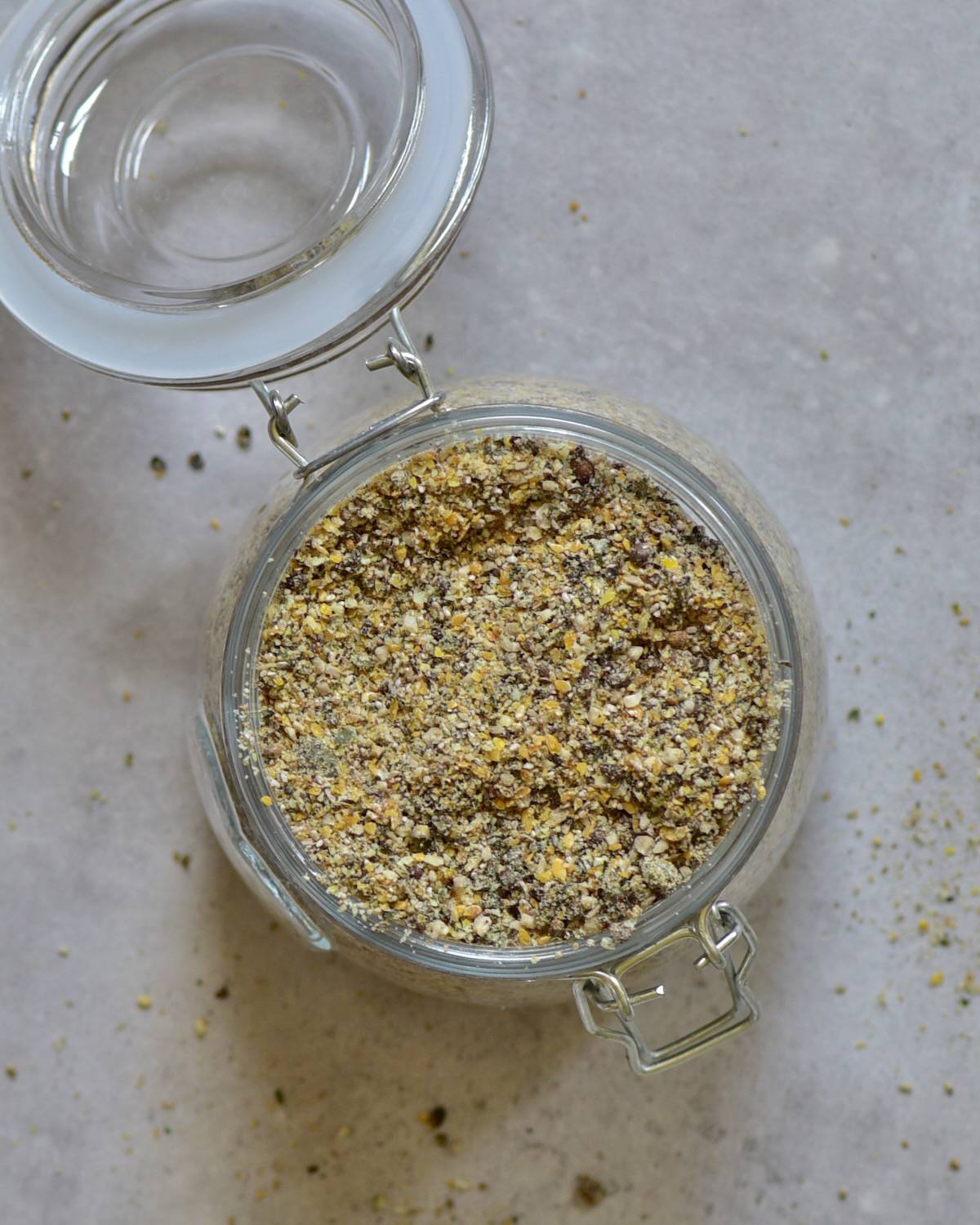
Best ways to use protein powder
This homemade vegan protein powder is great as a ‘topper’ or ‘add-in’ to boost protein content in:
- Oatmeal and overnight oats
- Smoothies, protein shakes, and smoothie bowls
- A yogurt parfait
- Over salads and soups, or in sauces (minus the vanilla)
- Sprinkled over a bagel or avocado toast
- As a topper for pancakes, waffles, and more (with berries and maple syrup)
- As a flour substitute (in small quantities) in pancakes, cookies, and quick breads
Storage instructions
Ground flaxseed/ chia seeds have the shortest shelf life due to their high oil content, which can quickly turn them rancid once ground. Combat this by only grinding them fresh or storing them separately in an airtight container in the fridge for 1 week or in the freezer for up to 3 months.
The remaining seed blend can be stored in the refrigerator for 1-2 months or in the freezer for up to 6 months.
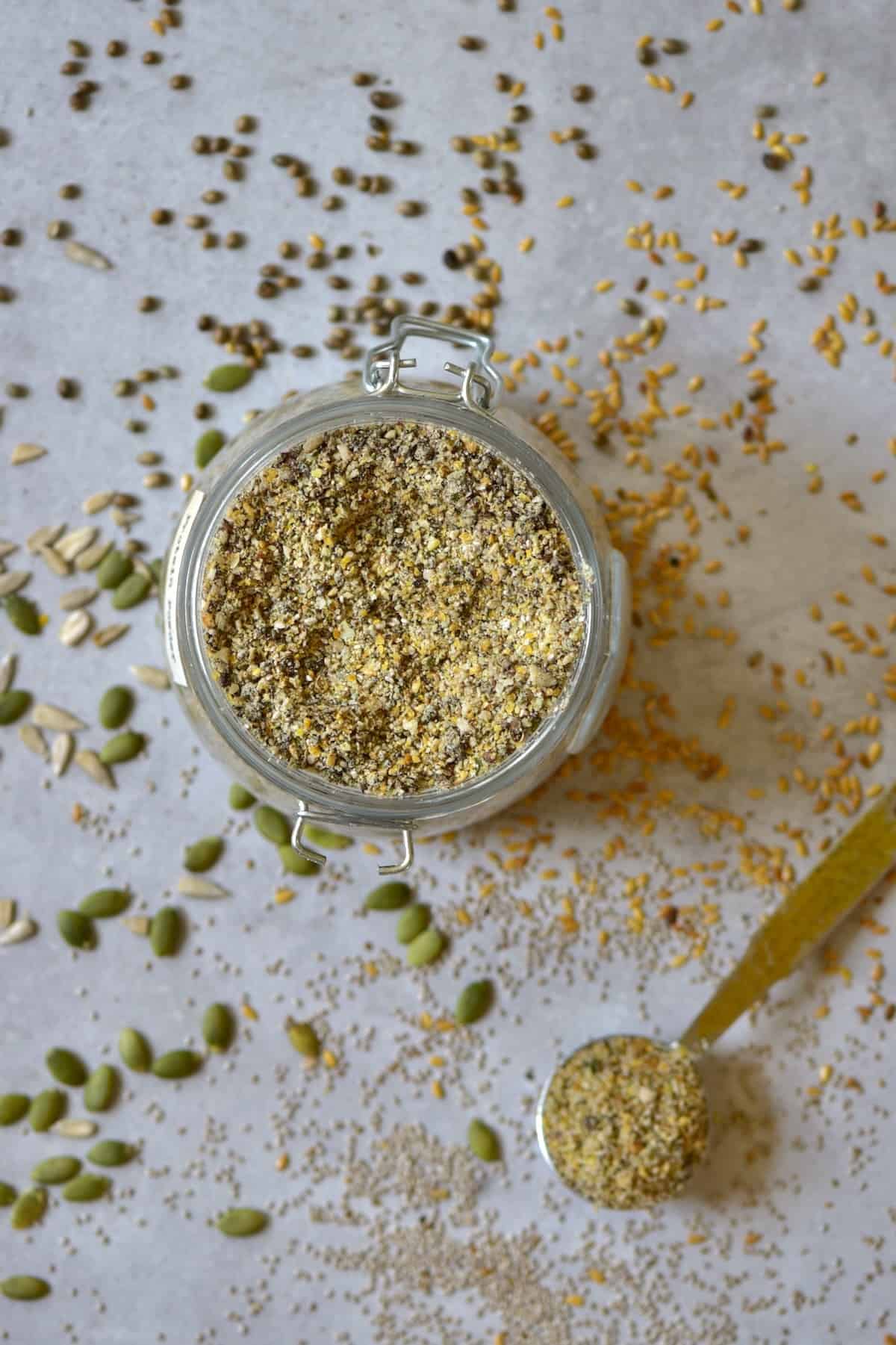
More protein-rich recipes
- Omega Seed Butter (5-Seed Butter)
- Breakfast Smoothie with Strawberries
- Cacao & Almond Protein Balls
- High-Protein Waffles
If you try this recipe, let me know how it goes in the comments below. I’d appreciate a recipe card rating and would love to see your recipe recreations – tag me on Instagram @Alphafoodie!
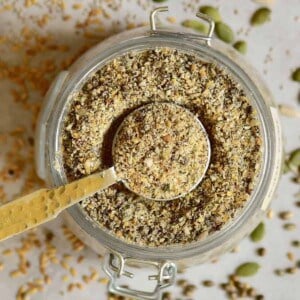
Simple Homemade Protein Powder
Ingredients
- 1/2 cup shelled hemp seeds also called hemp hearts (note un-shelled hemp seeds are photographed above)
- 1/2 cup chia seeds
- 1/2 cup pumpkin seeds
- 1/2 cup sunflower seeds
- 1/4 cup flax seeds
- 1/4 tsp vanilla powder optional OR 2-3 tsp cacao powder of freeze-dried berry powder.
Instructions
- Grind each seed individually in a high-speed blender or coffee/spice grinder. As a general rule:Hard seeds: Grind for 10-15 seconds or until you achieve a fine, powdery consistency. Pause and check the consistency to avoid over-processing them, as they can start turning into seed butter.Soft seeds: Grind for 5-10 seconds, and be cautious not to over-process them, or they can become gummy.
- Mix all ingredients and add the vanilla to the mixture. Store in an air-tight container.
Video
Notes
- Peanut powder (which contains 48-49 grams of protein per 100 grams)
- Pistachios (which contain 20 g protein per 100 grams)
- Pea protein isolate (which contains 80-84 g protein per 100 grams)
- Whey protein isolate (dairy-based, 90 g protein per 100 grams!)
- Whey protein concentrate (usually between 70-80g protein per 100 grams)
Nutrition
Nutrition information is automatically calculated, so should only be used as an approximation.

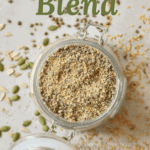
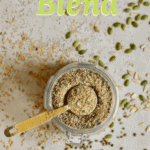









Hi
I already have protein powder that I buy regularly. Can I add this blend to it?
Hi Kurt,
If you feel like you need more protein, I don’t see why not. Please keep in mind that this homemade blend doesn’t dissolve in water.
What does this taste like? Can I add it something sweet or sour?
Hi Janet,
It tastes like a seed mix and you can add it to any food of your preference.
Thank you for sharing this amazing blog. It is easy to learn and understand. It’s a truly useful blog.
Thank you for your comment, Abrar!
Hi would like to know if your mix is soluble in water/milk
Thank you
Shirley
Hi Shirley,
No, unfortunately not.
Hi, can we mix this powder in roti dough?
Hi Manisha,
Yes, you should be able to add the powder to the dough.
Hi i am looking at the nutrition
Serving: 20g | Calories: 119kcal | Carbohydrates: 5g | Protein: 5g | Fat: 9g | Saturated Fat: 1g | Sodium: 2mg | Potassium: 92mg | Fiber: 3g | Sugar: 1g | Vitamin A: 35IU | Vitamin C: 1mg | Calcium: 57mg | Iron: 2mg
Is it that the protein is 5g per serving? Or 20g pr tbsp?
Hi Amanda,
The nutrition shown is for the suggested serving of 20 g – so it’s 5 g of protein in 20 g of powder (about 2.5 Tbsp of this blend). But please keep in mind that the nutritional information is calculated with an online database and, even though accurate metrics for the ingredients are provided, these figures should be considered only as an estimate.
I hope this helps.
Do you think i could make a protein powder blend could then be processed into a butter?
Hi Todd,
Yes, you could – if you blend the seeds with a food processor or a blender, after a while the powder will start to turn into a paste and then will become more runny (like a nut or seed butter). There is an Omega Seed butter recipe here on the blog if you want to check for more details – https://www.alphafoodie.com/super-omega-seed-butter/ (the ingredients are essentially the same).
I’m SO excited to find this recipe and can’t wait to try it along with the vanilla flavored powder. After my unsuccessful search for a clean, pre-packaged protein powder I realized I’d be hard pressed to find one without all the preservative junk. Thanks BUNCHES!
Thank you so much for your comment, Angela. I hope you like the results. You can also customize the mix depending on what seeds you have.
Can you please let me know, if I have to sprout pumpkin seeds and sunflower seeds? I used to soak them overnight and then dehydrate. How critical is that?
Hi Gulzat,
No you don’t have to sprout the seeds, but you can if you prefer to do that.
Sorry but you cannot eat any seed without activate them (soak them) except for hemp seeds. As they have anti-nutrient (phytic acid), meaning you wont be able to absorbe all they good nutrients unless they are previously activated. The reason for them to have anti nutrients is for the birds not to digest them and to poo them some where else to spread seeding. Not good for IBS to eat no activated seeds, nuts, grains, etc
Better to buy already activated seeds or soak them and put them in oven or dehydrator, better the second option to keep all nutrients.
Thank you for your comment, Pepa.
I have been making this exact five seed mix for about a year (using flax meal rather than the seeds) but never thought to make it into a powder. I just sprinkle it on my yogurt or oatmeal as is and enjoy the crunch. Hemp seeds can be hard to find. My recent purchase was at Trader Joes.
Thank you for your comment, Cheryl.
Yes, you can enjoy the seed mix both as a powder and as whole seeds. And you can mix and match the seeds depending on what you have available.
I’ve been making this powder for quite some time now but I wasn’t using pumpkin or sunflower seeds which I will do in my next patch clearly making it even more nutritious and tasty! Thank you for the great information, very well researched.
Thank you for your comment, Bob.
Hi I’m wondering how long this lasts in the fridge, I’m wanting to make protein balls
Hi Emma,
If you keep it in an air-tight container in the fridge, it will last at least a month. I hope this helps and you get to make the protein balls soon 🙂
Hi been looking at making seed milk, would you be able to use the protein blend to make milk, thank you, by the way love the protein powder mix.
Hi Andrew,
I have some seed milk recipes here on the blog. Check out my Guide for seed and nut milk for more information – https://www.alphafoodie.com/a-comprehensive-guide-to-vegan-dairy-free-milk/
So yes, you can definitely make milk with flaxseeds, hemp seeds, etc. I’ve never tried it myself, but you could probably make milk with this protein seed mix. I hope this helps.